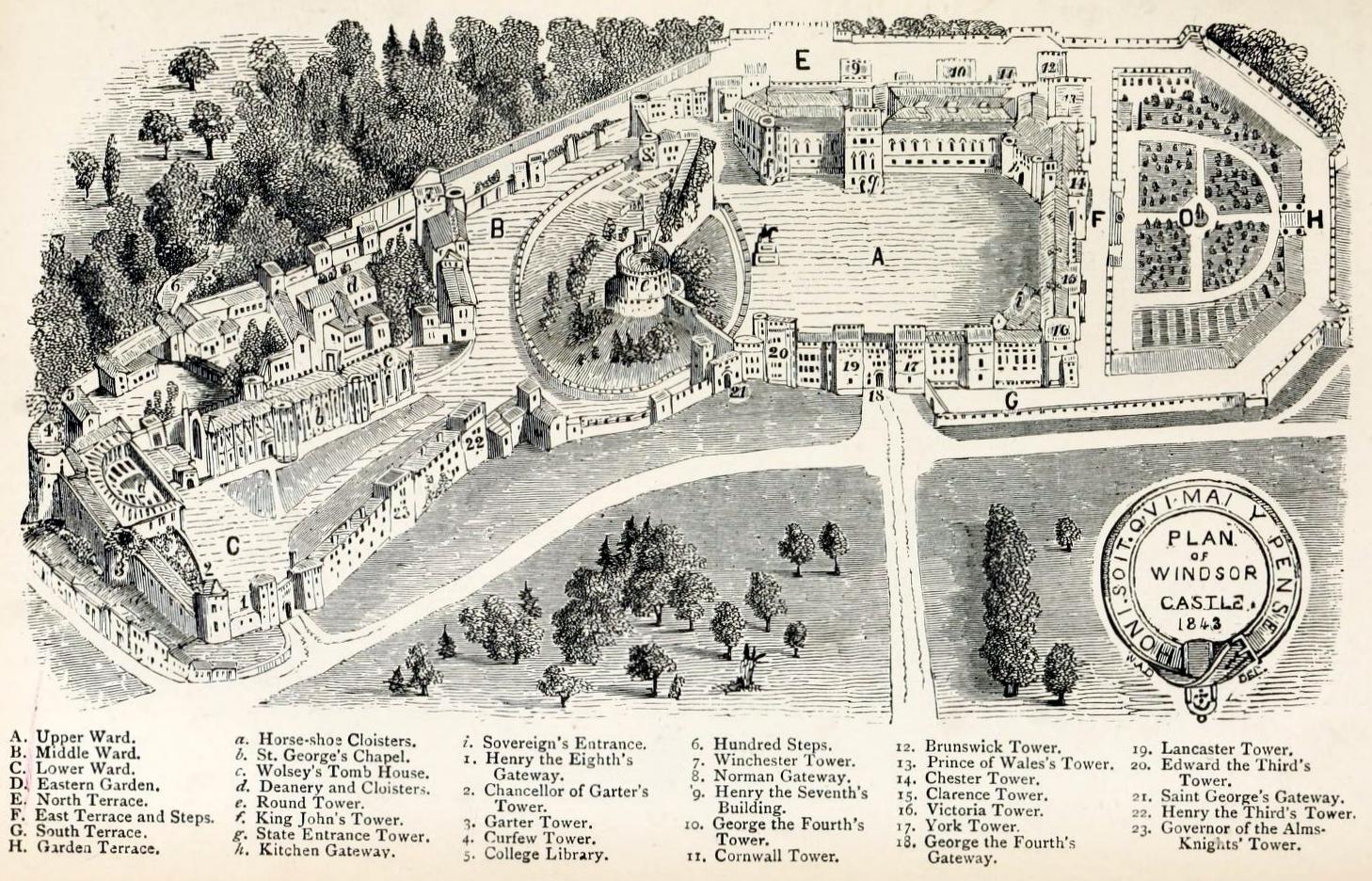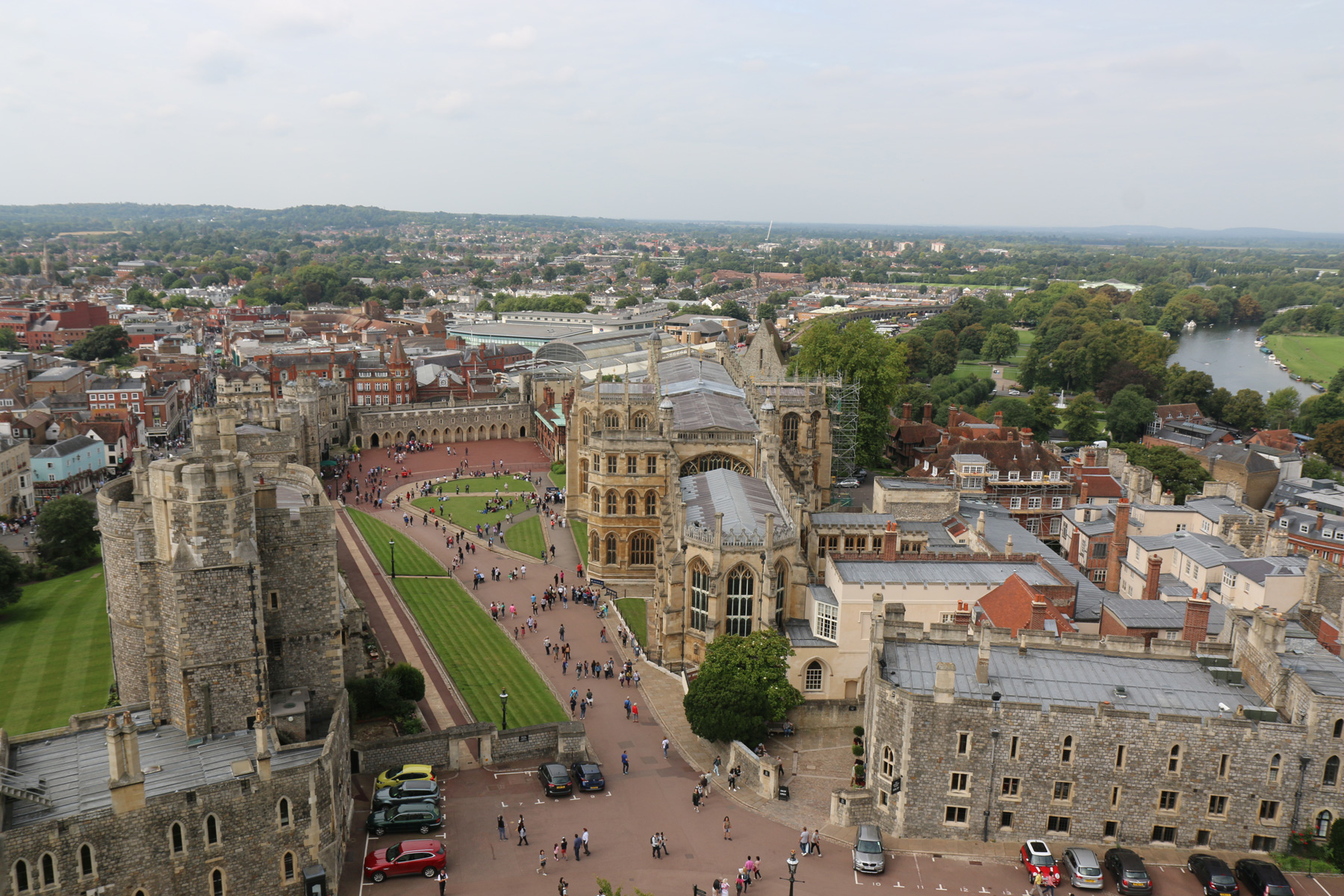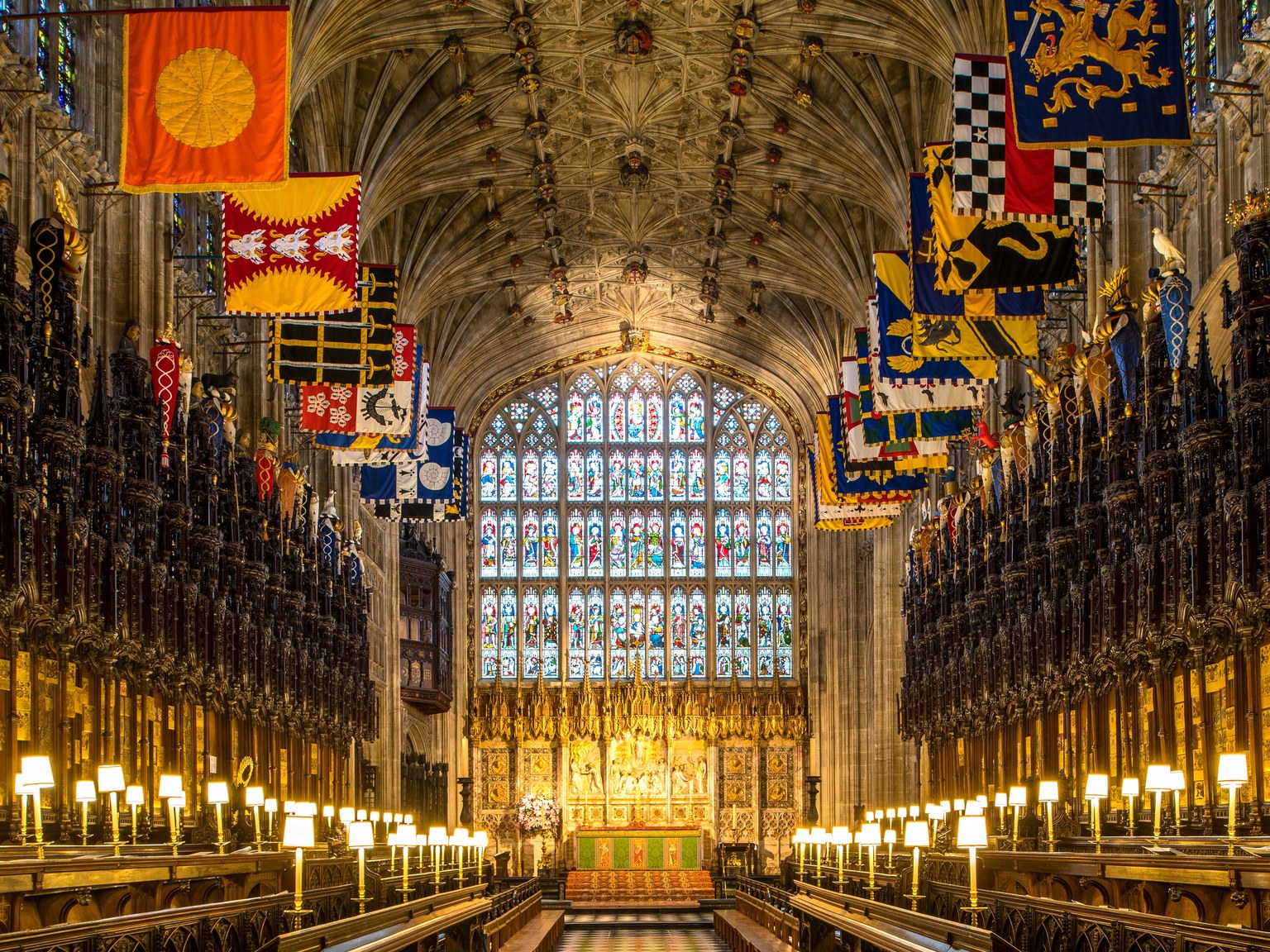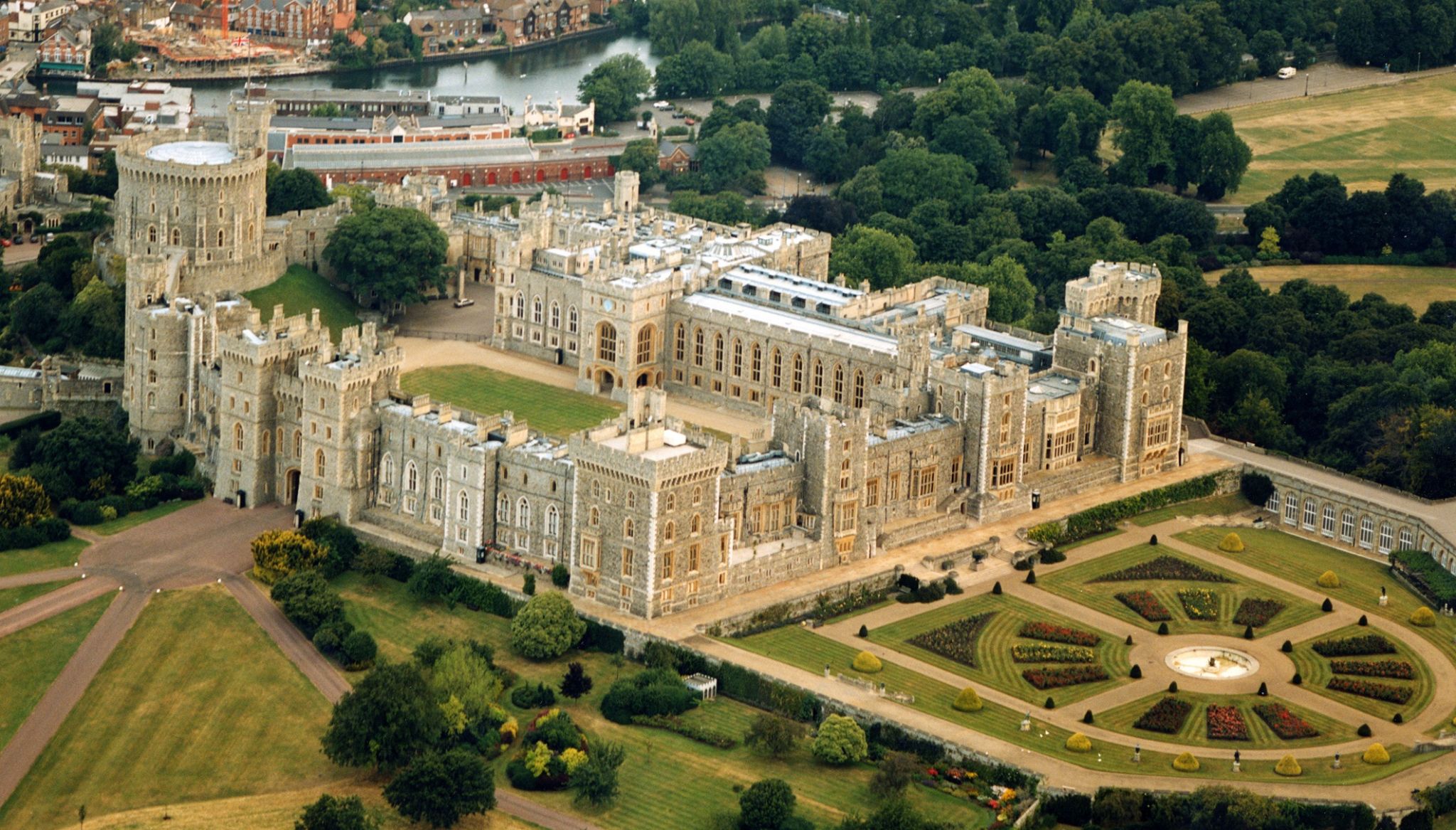

 Architecture
Neo-Gothic architecture
Architecture
Neo-Gothic architecture

 Architecture
Neo-Romanesque architecture
Architecture
Neo-Romanesque architecture
 England
England
 United Kingdom
United Kingdom
 Windsor Castle
Windsor Castle
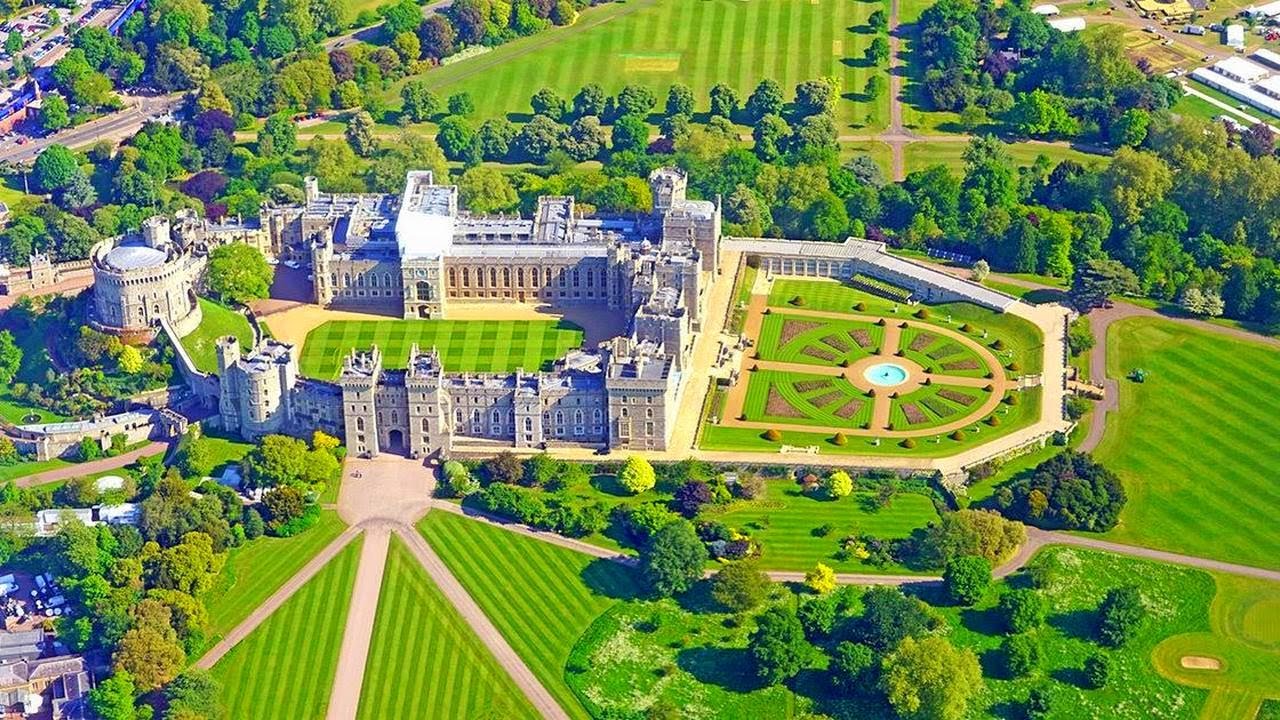
Windsor Castle ['wɪnzə 'kɑ:sl], auf Deutsch auch Schloss Windsor, ist das größte durchgängig bewohnte Schloss der Welt. Die Ursprünge von Windsor Castle liegen in der Zeit Wilhelms des Eroberers. Das Schloss befindet sich mit dem gesamten Windsor-Anwesen im Besitz der Krone und wird durch den königlichen Haushalt verwaltet. Es ist Teil der Royal Collection, während das Windsor-Anwesen dem Crown Estate untersteht.
Zusammen mit dem Buckingham Palace und dem Holyrood Palace in Edinburgh ist es eine der offiziellen Hauptresidenzen des britischen Monarchen. Die Burg liegt in der Stadt Windsor in der Grafschaft Berkshire im Landesteil England. Unterhalb der Burg fließt die Themse auf ihrem Weg nach Osten zur Hauptstadt London. Windsor Castle wird auch als „englisches Versailles“ bezeichnet.
Schloss Windsor war stets die offizielle Wochenend-Residenz der Könige und wurde von Königin Elisabeth II. zudem jährlich für einen Monat zu Ostern genutzt, während sie die Weihnachtsferien auf ihrem privaten Anwesen Sandringham House und die Monate August und September im schottischen Balmoral Castle verbringt. Anlässlich ihres 80. Geburtstags verlegte die Königin ihren ständigen Wohnsitz nach Windsor Castle und hält sich seither nur noch drei Tage pro Woche (gewöhnlich Dienstag bis Donnerstag) zu Arbeitszwecken im Londoner Buckingham Palace auf. Ihre Anwesenheit erkennt man an der königlichen Wappenstandarte auf dem Round Tower, während in ihrer Abwesenheit dort der Union Jack weht.
Die meisten Könige und Königinnen Englands hatten direkten Einfluss auf die Konstruktion und die Entwicklung des Schlosses, das ihnen zu ihren Zeiten jeweils als Garnison, Festung, Wohnhaus, offizieller Palast und manchmal auch als Gefängnis diente. Heute dienen die Gebäude sowohl als Museum als auch für staatliche Veranstaltungen sowie zu privaten Zwecken der Königin. Die Geschichte des Schlosses und die der britischen Monarchie sind untrennbar verbunden. Die Geschichte des Schlosses lässt sich chronologisch durch die Herrschaftszeiten der Monarchen nachvollziehen, die es besessen haben. Wenn das Land sich im Frieden befand, wurden dem Schloss große und prächtige Zimmer hinzugefügt. In Kriegszeiten wurde das Schloss stärker befestigt. Dieses Muster setzt sich bis in die heutige Zeit fort.
Windsor Castle is a royal residence at Windsor in the English county of Berkshire. It is notable for its long association with the English and later British royal family and for its architecture.
The original castle was built in the 11th century after the Norman invasion of England by William the Conqueror. Since the time of Henry I, it has been used by the reigning monarch and is the longest-occupied palace in Europe. The castle's lavish early 19th-century State Apartments were described by the art historian Hugh Roberts as "a superb and unrivalled sequence of rooms widely regarded as the finest and most complete expression of later Georgian taste".[4] Inside the castle walls is the 15th-century St George's Chapel, considered by the historian John Martin Robinson to be "one of the supreme achievements of English Perpendicular Gothic" design.[5]
Originally designed to protect Norman dominance around the outskirts of London and oversee a strategically important part of the River Thames, Windsor Castle was built as a motte-and-bailey, with three wards surrounding a central mound. Gradually replaced with stone fortifications, the castle withstood a prolonged siege during the First Barons' War at the start of the 13th century. Henry III built a luxurious royal palace within the castle during the middle of the century, and Edward III went further, rebuilding the palace to make an even grander set of buildings in what would become "the most expensive secular building project of the entire Middle Ages in England".[6] Edward's core design lasted through the Tudor period, during which Henry VIII and Elizabeth I made increasing use of the castle as a royal court and centre for diplomatic entertainment.
Windsor Castle survived the tumultuous period of the English Civil War, when it was used as a military headquarters by Parliamentary forces and a prison for Charles I. At the Restoration of the monarchy in 1660, Charles II rebuilt much of Windsor Castle with the help of the architect Hugh May, creating a set of extravagant Baroque interiors that are still admired. After a period of neglect during the 18th century, George III and George IV renovated and rebuilt Charles II's palace at colossal expense, producing the current design of the State Apartments, full of Rococo, Gothic and Baroque furnishings. Queen Victoria made a few minor changes to the castle, which became the centre for royal entertainment for much of her reign. Windsor Castle was used as a refuge by the royal family during the Luftwaffe bombing campaigns of the Second World War and survived a fire in 1992. It is a popular tourist attraction, a venue for hosting state visits, and the preferred weekend home of Elizabeth II.
Le château de Windsor (en anglais : Windsor Castle) est une forteresse médiévale située à Windsor dans le Berkshire au Royaume-Uni. Le château est célèbre pour son architecture et parce qu'il est l'une des résidences de la famille royale britannique. Sa construction commença peu après la conquête de l'Angleterre par Guillaume le Conquérant au XIe siècle. Depuis le règne d'Henri Ier d'Angleterre, le château a abrité de nombreux monarques ; il est le plus ancien palais habité sans interruption en Europe. La chapelle Saint-Georges, construite au XVe siècle, est considérée par l'historien John Martin Robinson comme « l'une des plus grandes réussites de l'architecture gothique anglaise ». Le style raffiné des appartements d'État construits au début du XIXe siècle a été vanté par l'historien de l'art Hugh Roberts, qui parle d'« une magnifique série de salles sans égales, largement considérées comme l'expression la plus élégante et la plus complète de l'art géorgien ». Plus de 500 personnes habitent et travaillent aujourd'hui dans le château.
Initialement construit pour assurer la domination normande sur les faubourgs de Londres et contrôler une portion stratégique de la Tamise, le château de Windsor était composé de trois palissades entourant une motte castrale. Progressivement renforcées par des murs en pierre, les fortifications résistèrent à un siège durant la première guerre des barons au début du XIIIe siècle. Henri III construisit un luxueux palais à l'intérieur de l'enceinte au milieu du siècle et Édouard III poursuivit ces travaux en transformant complètement le château dans ce qui devint le « plus onéreux projet de construction laïc de l'Angleterre médiévale ». Les monarques qui suivirent développèrent encore le château. Sous Henri VIII et Élisabeth Ire, il fut de plus en plus utilisé par la cour et pour les rencontres diplomatiques.
Le château de Windsor survécut à une période tumultueuse durant la première Révolution anglaise quand il fut utilisé comme quartier-général par les armées parlementaires et comme une prison pour Charles Ier. Durant la Restauration, Charles II reconstruisit une grande partie du château avec l'aide de l'architecte Hugh May (en) et créa les intérieurs baroques extravagants toujours visibles de nos jours. Après une période d'abandon relatif au XVIIIe siècle, George III et George IV rénovèrent à grands frais le palais de Charles II et donnèrent aux appartements d'État leur aménagement rococo, gothique et baroque. Victoria choisit Windsor comme sa résidence royale durant son long règne. Le château de Windsor fut utilisé comme refuge pour la famille royale durant les bombardements de la Seconde Guerre mondiale. En 1992, il fut victime d'un grave incendie. Il est aujourd'hui tout à la fois une attraction touristique populaire et la résidence préférée de la reine Élisabeth II.
Il Castello di Windsor è un palazzo e una residenza reale situato a Windsor, nella contea del Berkshire, Regno Unito, importante per la sua antica relazione con la Famiglia Reale Britannica e per la sua architettura. Fu un castello medievale cominciato a costruire nell'XI secolo, dopo la conquista normanna inglese di Guglielmo I il Conquistatore. Dal tempo di Enrico I d'Inghilterra (XII secolo) è stato abitato da numerosi monarchi britannici, che lo hanno reso un palazzo europeo abitato fin dall'antichità. Alcune delle sue camere più lussuose, come gli «Appartamenti di Stato», sono architettonicamente molto interessanti e sono stati descritti dallo storico Hugh Roberts come «una sequenza magnifica e impareggiabile di abitazioni ampiamente riconosciute come la maggiore e più completa espressione dello stile del periodo georgiano tardo».[1] Il castello include la Cappella di San Giorgio, del XV secolo, considerata dallo storico John Robinson come uno «dei successi supremi del disegno del gotico perpendicolare inglese».[2]
Questa fortificazione fu disegnata originariamente su una motta e con tre mura intorno ad un monte centrale per servire come roccaforte dei conquistatori normanni nella periferia di Londra e dominare una zona strategicamente importante del fiume Tamigi. La sua costruzione fu gradualmente sostituita con pietre, e a partire del XIII secolo soffrì di un lungo assedio durante la Prima Guerra dei Baroni (1215-17). Enrico III costruì un lussuoso palazzo reale dentro a queste mura a metà del secolo e Edoardo III è andato oltre con la ricostruzione del palazzo, che creò un maggior complesso di edifici che si convertirà nel «progetto architettonico secolare più caro di tutto il Medioevo in Inghilterra».[3] Il nucleo dell'opera di Edoardo vi fu fino al periodo Tudor (XVI secolo), quando Enrico VIII e Elisabetta I diedero al castello un maggiore uso come corte reale e centro dell'intrattenimento diplomatico.
Il complesso sopravvisse al turbolento periodo della Guerra Civile inglese, usato come quartiere militare dalle forze parlamentari e come prigione di Carlo I. Durante la Restaurazione degli Stuart, Carlo II ricostruì gran parte del castello con l'aiuto dell'architetto Hugh May e creò una serie di stravaganti interni barocchi che tuttavia oggi causano ammirazione. Dopo un periodo di negligenza nel XVIII secolo, i re Giorgio III e Giorgio IV rinnovarono e ricostruirono il palazzo di Carlo II senza badare a spese per produrre il disegno degli attuali Appartamenti di Stato, decorati in stile rococò, gotico e barocco. La regina Vittoria realizzò cambiamenti minori nel castello, che ampliò come centro d'intrattanimento reale durante gran parte del suo esteso regno nel XIX secolo. Il castello di Windsor servì inoltre come rifugio della famiglia reale durante intensi bombardamenti della Seconda Guerra Mondiale e sopravvisse ad un incendio nel 1992. Attualmente nel castello di Windsor vivono e lavorano più di cinquecento persone, è un'attrazione turistica molto popolare, sede di visite di Stato e luogo per i fine settimana preferito dalla regina Elisabetta II d'Inghilterra.
El conocido como Castillo de Windsor es un palacio y residencia real situado en Windsor, en el condado de Berkshire, Reino Unido, notable por su antigua relación con la Familia Real Británica y por su arquitectura. Su origen fue un castillo medieval comenzado a levantar en el siglo XI, tras la conquista normanda de Inglaterra por Guillermo I el Conquistador. Desde tiempos de Enrique I de Inglaterra (siglo XII) ha sido habitado por numerosos monarcas británicos, hecho que lo convierte en la segunda residencia real europea de ocupación más antigua tras el Real Alcázar de Sevilla.1 23 Algunas de sus lujosas estancias, como los «Apartamentos de Estado», son arquitectónicamente muy interesantes y han sido descritas por el historiador Hugh Roberts como «una secuencia magnífica e inigualable de habitaciones ampliamente reconocidas como la mejor y más completa expresión del estilo del periodo georgiano tardío».4 El castillo incluye la Capilla de San Jorge, del siglo XV, considerada por el historiador John Robinson como uno «de los logros supremos del diseño del gótico perpendicular inglés».5
Esta fortificación fue diseñada originalmente sobre una mota y con tres murallas en torno a un montículo central para servir como baluarte de los conquistadores normandos en las afueras de Londres y dominar una zona estratégicamente importante del río Támesis. Su fábrica fue gradualmente sustituida por piedra, y a comienzos del siglo XIII sufrió un largo asedio durante la Primera Guerra de los Barones (1215-17). Enrique III construyó un lujoso palacio real dentro del recinto a mediados de ese siglo y Eduardo III fue más allá con la reconstrucción del palacio, que creó un conjunto mayor de edificios que se convertiría en «el proyecto arquitectónico secular más caro de toda la Edad Media en Inglaterra».6 El núcleo de la obra de Eduardo pervivió hasta el período Tudor (siglo XVI), cuando Enrique VIII e Isabel I le dieron al castillo un uso mayor como corte real y centro de entretenimiento diplomático.
El complejo sobrevivió al turbulento período de la Guerra Civil inglesa, en que fue usado como cuartel militar por las fuerzas parlamentarias y como prisión de Carlos I. Durante la Restauración de los Estuardo, Carlos II reconstruyó gran parte del castillo con ayuda del arquitecto Hugh May y creó una serie de extravagantes interiores barrocos que todavía hoy causan admiración. Tras un período de negligencia en el siglo XVIII, los reyes Jorge III y Jorge IV renovaron y reconstruyeron el palacio de Carlos II sin reparar en gastos para producir el diseño de los actuales Apartamentos de Estado, engalanados en estilo rococó, gótico y barroco. La reina Victoria realizó cambios menores en el castillo, que empleó como centro de entretenimiento real durante gran parte de su extenso reinado en el siglo XIX. El castillo de Windsor también sirvió como refugio de la familia real durante los intensos bombardeos de la Segunda Guerra Mundial y sobrevivió a un incendio en 1992. En la actualidad en el castillo de Windsor viven y trabajan más de quinientas personas, es una atracción turística muy popular, sede de visitas de Estado y el hogar de fin de semana preferido por la reina Isabel II de Inglaterra.
Ви́ндзорский за́мок[2] — резиденция британских монархов в городе Виндзор, графство Беркшир, Англия. На протяжении более 900 лет замок являет собой незыблемый символ монархии, возвышаясь на холме в долине реки Темзы. Его именем назвалась ныне правящая в Англии королевская династия (с 1917 года). За почти тысячелетнюю историю Виндзорский замок изменялся и расширялся в соответствии со временем, вкусами, требованиями и финансовыми возможностями существующих монархов. Однако положение основных строений осталось без особых изменений. В настоящее время замок располагается вокруг искусственного холма («A» на плане), на котором Вильгельм Завоеватель построил первый деревянный замок[3].

